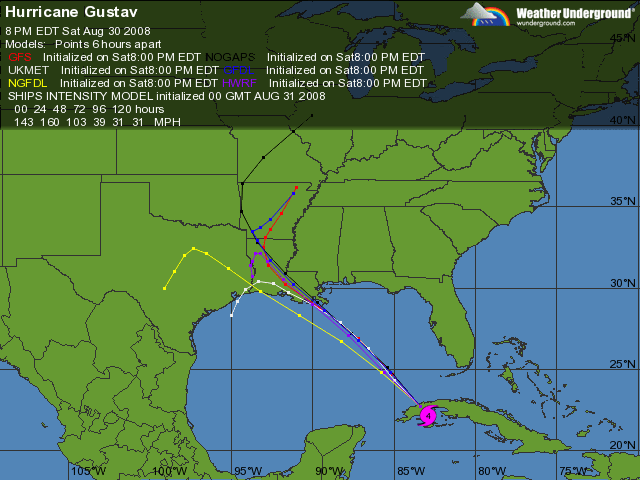New York Times wrote:Hurricane Gustav Strengthens to Category 4
By ADAM NOSSITER and SHAILA DEWAN
NEW ORLEANS — As potentially dangerous Hurricane Gustav approached the Louisiana coast on Saturday, New Orleans began a far more carefully planned evacuation of the city than it experienced exactly three years ago when Katrina struck. Buses began ferrying low-income residents to shelters in the north, cars began streaming out on interstate highways and hotels shooed away valuable tourists.
New Orleans was expected to get at least tropical-storm-force winds from Hurricane Gustav by Monday. By midday Saturday the storm had strengthened into a Category Four hurricane with winds of up to 145 miles per hour as it moved toward Cuba and the Gulf of Mexico, and forecasters said it was most likely to strike the Louisiana coast early Tuesday. New Orleans could get winds of up to 73 miles per hour, and possibly greater.
Officials here, exercising deliberate caution after the disaster of three years ago, said they could declare a mandatory evacuation of the city by early Sunday morning.
“I am strongly, strongly encouraging everyone in the city to evacuate,” Mayor C. Ray Nagin said in a news conference Saturday afternoon. “Start the process now. Go north if you can because the storm may continue to turn a little bit west.”
Mr. Nagin said that if the hurricane continues on its current path, a mandatory evacuation will be implented — probably about 8 a.m. Sunday.
Hotels were closing, and the sound of boards being hammered over windows could be heard. The state police on Saturday morning reported moderately heavy traffic on a principal highway north, Interstate 55, and a voluntary city-organized evacuation plan for the poor, elderly and sick — the principal victims in Hurricane Katrina — was in full swing.
Dozens waited outside for buses at 17 collection points all over the city to take them to the Union Passenger Terminal, the train station downtown. From there they will be taken by bus and train to cities in north Louisiana — Shreveport, Alexandria and Monroe — and to Memphis. They clutched duffle bags, plastic shopping sacks, small children and overstuffed suitcases, vowing to avoid at all costs the still-vivid nightmare of Katrina.
The buses arrived promptly at 8 a.m. — a sharp contrast to the chaos and disorganization of three years ago, when the only plan was to jam thousands of people without cars into the Superdome and let others fend for themselves.
“I refuse to go through that again,” said Roxanne Clayton, a photo technician at Walgreens, who was waiting in the Irish Channel neighborhood with her teenage son and 10-year-old daughter. She recalled being stuck in her attic for two days during Hurricane Katrina. “I’d rather play it safe than sorry, because I know what sorry feels like,” Ms. Clayton said.
A neighbor from the larger houses up Louisiana Avenue brought doughnuts for those patiently waiting, and many said they were simply grateful for the ride out of town.
In the Tremé neighborhood, bordering the French Quarter, large families without cars, and some who were simply homeless, waited for buses that quickly filled. “If you’ve been through Katrina, it’s time for you to go,” said Marion Colbert, a powder room attendant at a French Quarter restaurant for more than three decades. “You never know about these storms if you’ve been living in the city 80 years.”
In the Central City section, families, elderly men and the visibly infirm — people in wheelchairs and with canes — lined the sidewalk along Dryades Street for half a long block. “After going through Katrina, that ain’t no joke,” said Jody Anderson, who spent seven days in the Superdome. “It’s not worth it, trying to stay,” said Ms. Anderson, an unemployed former cashier.
Still, there were few signs of a mass exodus, though gasoline stations were crowded. With forecasters not predicting a direct hit on New Orleans, some here had made the decision to stay. “My sense from talking to citizens is that they are either in an extreme state of ‘anxious to leave,’ or they’re just tired and ‘I don’t want to be bothered,’ ” Mayor Nagin told reporters late Friday.
State officials prepared an elaborate system of contraflow lanes on interstate and federal highways leading out of southern Louisiana, staging the plans so that those farthest south could exit first. In St. Bernard Parish, just east of New Orleans, officials ordered a mandatory evacuation beginning at 4 p.m. Saturday, warning residents that curfews would be enforced. The parish was one of the hardest hit in Hurricane Katrina, and many of its residents never returned.
Hurricane Gustav remained south of Cuba early Saturday, having already killed 78 people in the Caribbean. Forecasts of its track said it could strike the United States mainland from the Florida panhandle on the east to the Texas coast, though the center of the track remained the Louisiana coast well west of New Orleans. Whatever its exact landing point, storm surges could cause serious damage throughout the region.
Contributing to some greater sense of security this time around are improvements to the system of levees around the city that failed so disastrously last time.
In particular, floodgates have been constructed at the end of city drainage canals leading to Lake Pontchartrain — the principal conduits for the fateful surge during Katrina. Still, there is no such arrangement on the Industrial Canal, the surge from which destroyed the still-empty Lower Ninth Ward.
Some institutions — hospitals and nursing homes, where many died during Katrina — were taking no chances, already ferrying patients north of the area on Friday.
The Louisiana National Guard’s 7,000 troops were mobilized on Friday, and 1,500 were on the ground in New Orleans, in part to forestall looting, a serious problem during Katrina.
Amber Hebert of the state transportation department said that 14,000 people had registered for the evacuation program and that about 150 buses were already in use, with 300 school buses to be pressed into service by Saturday afternoon.
Meanwhile, Mr. Nagin said a city hotline on assisted evacuations had been “bombarded” with some 17,000 calls. The city plans to send police and firefighters into the neighborhoods with bullhorns, urging residents to leave. Many clearly needed no such encouragement.
“I don’t want to be stuck like I was in Katrina,” said Janice McElveen, who recalled being stranded on the I-10 bridge for five days. She was waiting for a bus in the Irish Channel.
At the St. Claude Car Wash, a line of cars stretched down the street, waiting to get leaky tires repaired and flats replaced for the drive out of town. Barry Martin, a United Parcel Service worker waiting, said it was the shortest of several lines he had seen. His sport-utility vehicle was empty of luggage; Mr. Martin said he would leave early Sunday morning, picking his destination based on which direction had the lightest traffic. “If everyone’s heading west,” he said, “I’m going to go to Florida.”
For others here, the party was not yet over. Troy Meryhew, in town for Southern Decadence, a festival for gay men and lesbians, said the storm had had little effect on the festivities — except for the sawing and hammering as his hotel boarded up windows. He said his flight on Monday was still scheduled to depart, and the hotel was staying open. “As long as our hotel’s open and there’s liquor, we’re fine,” Mr. Meryhew said.
But Mayor Nagin was urging all tourists to leave immediately. “Tourists definitely get out,” he said Saturday. “And then the next time you hear us it’s going to be get the heck out.”
Michelle Barnes, a French Quarter resident, was nearly in tears, worried that she would not be allowed on the bus with her little dog, Jack, who was resting in a black canvas bag. Evacuees had been instructed to keep their pets in a carrying case, but Ms. Barnes did not have one. “I just hope,” Ms. Barnes said, “because otherwise I won’t leave.”
Melvin McKay, 69, had neatly written his name, phone number and address, and that of his 86-year-old sister, on cards cut from a manila folder, in case the family got separated, as was the case with so many Katrina evacuees. Mr. Melvin, whose sister uses a wheelchair, was anxiously conferring with Amelia Francis, 82, who also uses one, because the first two buses to arrive did not have wheelchair lifts. Mr. Melvin said that if all else failed, he could drive his sister to the train station, but his car was not fit to leave the city.
A little while later a wheelchair van arrived and the concern was resolved.
Carla Baranauckas contributed reporting from New York.









